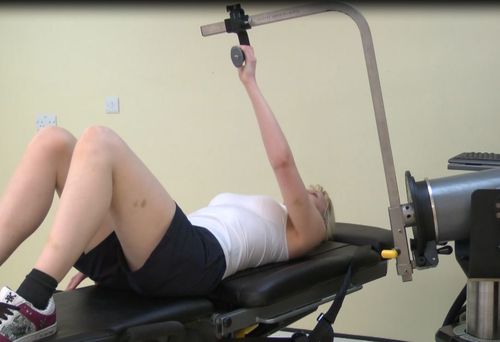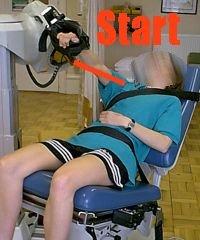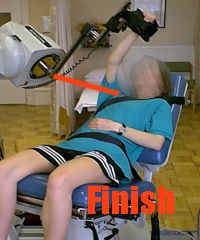There are two main diagonal patterns available on isokinetic machines. They mimic the proprioceptive neuromuscular patterns (PNF). The two movements are:
PNF 1: Extension / abduction / external rotation to flexion / adduction / internal rotation
PNF 2: Flexion / abduction / external rotation to extension / adduction / internal rotation
These movements can be performed in either the lying or seated positions.
Lying position:
In the supine position (see below) stabilization is effectively achieved by the contact between the thorax and the bed. Testing in this position is more stabilised than in the seated position and allows a fuller range of motion.

To view a set up video for PNF1 see below
To view a set up video for PNF2 see below
Seated position:
This position is only available on a dynomometer with allot of height adjustment (KIn-Com). When using the seated position the thoracic belts should be utilized to prevent upper body movements. The position is inherently unstable so it is only recommended for patients and not for research.


Stabilisation:
Lying: Stabilisation in the lying position is not normally required as this is inherent in the position.
Seated: In the seated position stabilisation usually involves chest straps.
Attachments:
There is validity in using a wrist strap (as seen in seated above) rather than a grip handle (as seen in lying above) because this eliminates the influence of the wrist flexors and extensors. Although this may have some face validity it does not translate into real world testing. The hand grip is then always preferable and should be left UNLOCKED to allow rotation.
Make sure the elbow has a small degree of flexion throughout the range to ensure it’s safety (5 degrees is usually enough).
Axis of rotation:
No studies are available which can completely describe the instantaneous axis of rotation during diagonal movements. Use a position which allows the ROM you wish to test/exercise through. As can be seen in seated above the alignment of the axis of rotation will often be altered even with thoracic and pelvic stabilization.
Anatomical zero:
With arm at 90 degrees to the thorax (in seated pointing at 45 degrees to floor in lying pointing to the roof).
Range of motion:
Generally a large range of motion is chosen for these tests. The greater the range the better.
Gravity correction:
In lying position: As the lever arm can be very long and heavy in these movements setting of gravity correction is essential.
In sitting: Gravity correction can make the difference between a good test and a very poor test.
Speeds:
Generally it is accepted that speeds of 30 degrees/second and multiples of this should be used.
Shoulder Diagonal (PNF) Protocols:
Muscles involved:
Subscapularis, infraspinatus, supraspinatus, teres minor, latissimus dorsi, teres major and pectoralis major
| Strength Test Protocols | General | Patients | Athletes | Research |
| Contraction Cycle | con/con | con/con | con/concon/ecc | con/conecc/ecc |
| Speed/s | 60 or 90 | 30 or 60 | 30-300 | 30-500 |
| Trial Repetitions | 0 | 0 | 0 | 3 |
| Repetitions | 10 | 10 | 10 | 5 |
| Sets | 3 | 3 | 4 | up to 9 |
| Rest between sets | 20-30 secs | 20-30 secs | 20-30 secs | 20 secs |
| Rest between speeds | 2 minutes | 2 minutes | 2 minutes | 2-5 minutes |
| Rest between sides | 5 minutes | 5 minutes | 5 minutes | 5 minutes |
| Feedback | nil | nil | nil | nil |
| Endurance Test Protocols | General | Patients | Athletes | Research |
| Contraction Cycle | con/con | con/con | con/concon/ecc | con/conecc/ecc |
| Speed/s | 90 | 60 | 60-300 | 30-500 |
| Trial Repetitions | 0 | 0 | 0 | 0 |
| Repetitions | Max | Max | Max | Max |
| Sets | 1 | 1 | 1 | 1 |
| Rest between sets | N\A | N/A | N/A | N/A |
| Rest between speeds | 10-15 mins | 10-15 mins | 10-15 mins | 10-30 mins |
| Rest between sides | 5 mins | 5 mins | 5 mins | 5 mins |
| Feedback | nil | nil | nil | nil |
| Strength Exercise Protocol | General | Patients | Athletes |
| Contraction Cycle | con/con | con/con | con/ecc |
| Speed/s | 30 up to 180 | 30 up to 180 | 60-300 |
| Trial Repetitions | 0 | 0 | 0 |
| Repetitions | 10 | 10 | 14 |
| Sets | 6 | 6 | up to 12 |
| Rest between sets | 30-60 secs | 30-60 secs | 30 secs |
| Rest between speeds | 2 mins | 2 mins | 2 mins |
| Rest beween sides | Nil | Nil | Nil |
| Feedback | bar | bar | bar |
| Endurance Exercise Protocol | General | Patients | Athletes |
| Contraction Cycle | con/con | con/con | con/con |
| Speed/s | 60-180 | 60-180 | 60-300 |
| Trial Repetitions | 0 | 0 | 0 |
| Repetitions | Max | Max | Max |
| Sets | 1-3 | 1 | 1-3 |
| Rest between sets | 5-10 mins | N/A | 5-10 mins |
| Rest between speeds | 10-30 mins | N/A | 10-30 mins |
| Rest between sides | Nil | Nil | Nil |
| Feedback | bar/pie chart | bar/pie chart | bar/pie chart |
Notes:
Test the uninvolved or dominant limb first. Very variable results.
Interpretation:
In the shoulder it is normal to look at the ratio between the right and left sides there should be a 0-10% difference between the sides. Anything beyond this would either demonstrate extreme hand dominance (this can happen in certain sports like javelin), or indicate a muscle imbalance which would be best corrected.
Eccentric results are generally 30% higher than concentric within the same muscle.
Angle of peak torque has not been established.
Normative values:
None available.